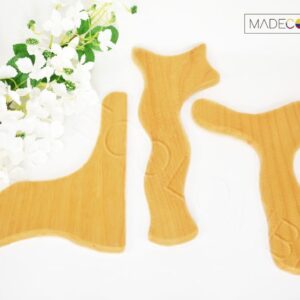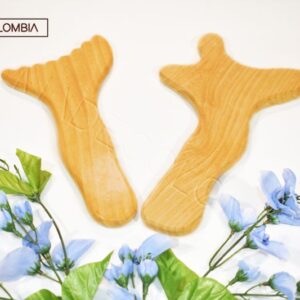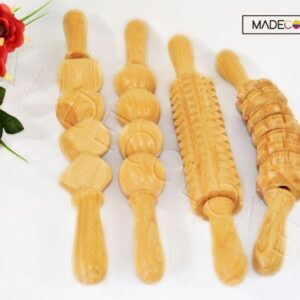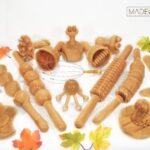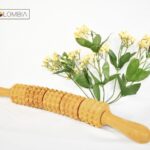Maderotherapy: A Natural Therapy to Reduce Cellulite

Maderotherapy as an Alternative Culture Maderotherapy is an alternative cultural therapy that uses various wooden instruments to massage the body and promote well-being. It is considered an ancient technique with roots in different cultures such as Chinese, Egyptian, and Mexican. Although its origins are ancient, Maderotherapy has gained relevance in modern society due to its therapeutic benefits and its focus on body balance and harmony.
Maderotherapy is based on the idea that wood has healing and energetic properties. Therapists use a variety of carved wooden instruments such as rollers, cylinders, cups, and spatulas to perform massages and manipulations on the body. Each instrument has a specific shape and size that adapts to different body parts and massage techniques.
The goals of Maderotherapy are multiple. Firstly, it aims to improve blood and lymphatic circulation, helping to eliminate toxins and reduce fluid retention. It can also tone and firm tissues, contributing to the fight against cellulite and improving skin appearance. Additionally, Maderotherapy can relieve muscle tension, reduce stress, and promote an overall sense of relaxation and well-being.
Maderotherapy has gained popularity in modern society due to its natural and non-invasive approach. Many people seek alternatives to conventional medical treatments and prefer therapies that work with the body’s natural resources. Moreover, Maderotherapy has been promoted as a complementary technique in the beauty and personal care industry, as it can help improve skin appearance and reduce signs of aging.
It’s important to note that while Maderotherapy can provide therapeutic benefits, it does not replace proper medical diagnosis or treatment. If you’re interested in trying Maderotherapy, it’s recommended to seek a certified therapist and discuss your needs and previous health conditions.
Is Maderotherapy an Effective Technique? Maderotherapy is considered an effective technique for various health and well-being-related benefits. If performed correctly and by a trained therapist, it can provide positive results in different areas of the body.
Medical professionals have confirmed that Maderotherapy is effective in improving blood and lymphatic circulation, as well as helping reduce fluid retention, among other benefits we’ll discuss below.
What Benefits Can We Obtain from Maderotherapy? Wood therapy, or therapy with wood, offers a variety of health and well-being benefits. Here, I’ll detail each of them:
- Benefits Blood Circulation: Wood therapy uses wooden instruments for massages and manipulations on the body. These movements stimulate blood circulation, helping to improve the flow of blood and oxygen to the tissues. Better circulation can have positive effects on overall health, such as reducing the feeling of tired legs, preventing clot formation, and improving cardiovascular function.
- Regulates Lymphatic Circulation and Reduces Adipose Tissue: Wood therapy also influences the lymphatic system, responsible for eliminating toxins and waste from the body. Massage movements with wood stimulate lymphatic flow, helping to reduce fluid retention and decrease adipose tissue. This can have a reducing effect on problem areas such as thighs, abdomen, and buttocks.
- Tones and Firms the Skin: Massages with wooden instruments in wood therapy can improve the appearance and texture of the skin. These movements stimulate the production of collagen and elastin, proteins responsible for skin elasticity and firmness. Additionally, massage helps improve circulation in the skin, giving it a healthier and more radiant appearance.
- Improves Production of Elastin, Collagen, and Vitamin E: Wood therapy promotes the production of elastin and collagen, which are crucial for skin elasticity and structure. These proteins help maintain firm skin, reduce the appearance of wrinkles, and promote a more youthful appearance. Furthermore, wood therapy has been observed to stimulate the production of vitamin E, an important antioxidant for skin health.
- Enhances Muscle Tone: Massage movements with wooden instruments in wood therapy can help tone and strengthen muscles. These specific massages stimulate muscle contraction and promote blood circulation in the treated area, contributing to improved muscle tone and body shaping.
- Cellulite Treatment: Wood therapy is considered an excellent treatment for cellulite. Massages with wooden instruments help break down fat deposits, improve circulation, and stimulate lymphatic drainage. This can reduce the appearance of cellulite and improve skin texture in problem areas.
These treatments are usually part of a comprehensive approach that includes other care and healthy habits, such as a balanced diet and regular physical activity. Additionally, wood therapy may not be suitable for everyone, especially those with certain medical conditions or skin sensitivities. Therefore, it’s crucial to consult with a specialized therapist and obtain a personalized assessment before undergoing these treatments.
Other Ways to Treat Cellulite There are other ways to reduce cellulite besides Maderotherapy. Cellulite is a condition where adipose tissue accumulates under the skin, creating dimples and an irregular appearance in areas such as the thighs, buttocks, and abdomen. We recommend maintaining proper hydration, a balanced and healthy diet, regular physical activity, deep massages (not necessarily with wooden tools), and the use of creams and topical treatments.
How Many Maderotherapy Sessions Are Needed to See Results? The number of Maderotherapy sessions required to see results can vary from person to person, depending on individual goals and specific treatment characteristics. There is no exact number of sessions that applies to everyone, as each case is unique. However, in general, it is recommended to complete a cycle of sessions to achieve significant results.
In general terms, it is suggested that a Maderotherapy cycle consists of 8 to 12 sessions, with a frequency of 1 to 2 sessions per week. This allows the body time to respond to stimuli and adapt to the changes being generated. However, this number can vary depending on individual needs and goals.
Regarding the approximate duration of each Maderotherapy session, it typically ranges from 30 to 60 minutes. The exact duration may depend on factors such as the body area being treated, the technique used, and the specific needs of the client. A trained therapist will determine the appropriate time for each session based on individual circumstances.
It’s important to note that Maderotherapy results are not immediate and require time and consistency. So, don’t worry if you don’t see changes instantly.
Related posts
Transform Your Well-being with Maderotherapy: Discover Its Benefits
Reshape Your Figure: How Maderotherapy Can Help You Achieve It
Maderotherapy: The Ancient Secret to Radiant Skin
Millennial Therapy: Everything You Need to Know About Maderotherapy
The Art of Wooden Massage: Exploring Maderotherapy
Are you interested
in wholesaling?


